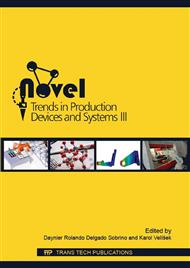p.3
p.11
p.18
p.26
p.33
p.41
p.49
p.59
Tool Wear and Surface Roughness Evolution in Hole Making Process of Inconel 718
Abstract:
The paper focuses on tool wear and surface roughness indicators evaluation associated with hole making of nickel based super alloy Inconel 718 widely used in aero engine industry. Within study of tool wear and surface integrity, series of experimental tests were performed on an Inconel 718 specimen. Special attention was paid to ensure that the cutting conditions correspond to the industrial practice. Two steps of hole making sequence consists of a drilling process applying a twist drill that removes most of the stock. This operation is followed by a second machining process, typically applying a face – cutting finisher (reamer), which removes an additional (radial) stock between 0.1 mm to 0.25 mm per side. Tool wear appeared predominantly as flank wear VBmax and evolution of surface roughness Ra and Rz has a similar trend for drilling and finishing.
Info:
Periodical:
Pages:
11-17
Citation:
Online since:
August 2016
Authors:
Keywords:
Price:
Сopyright:
© 2016 Trans Tech Publications Ltd. All Rights Reserved
Share:
Citation:


